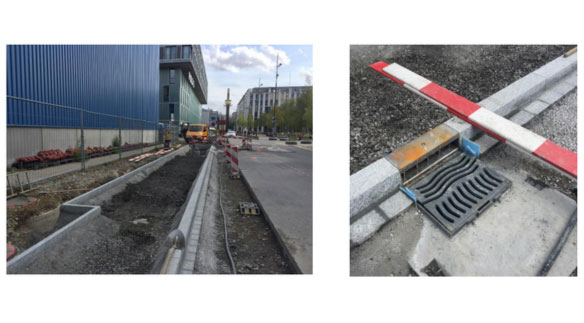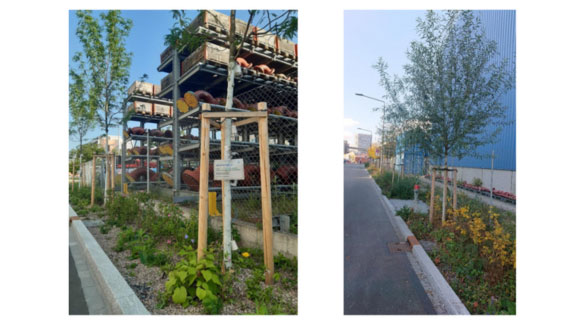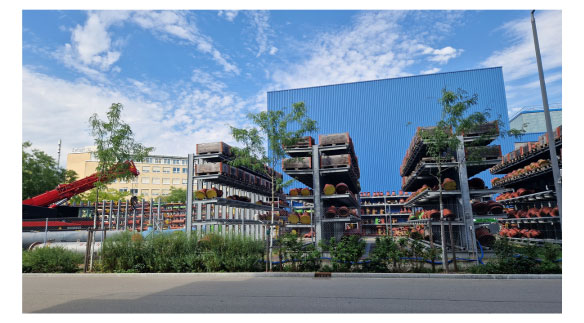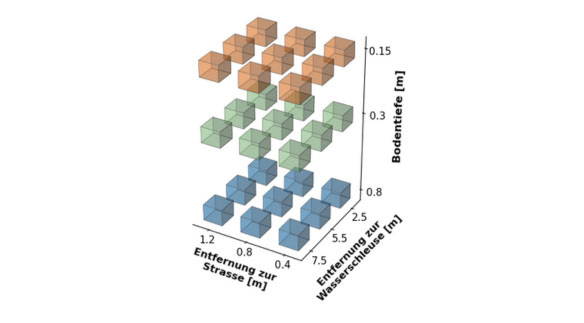
When Zurich Becomes A Sponge City – A Data Science Research Project by Sascha Kappeler
Climate extremes such as droughts, heat waves and heavy rainfall are becoming more frequent and are affecting even large cities such as Zurich. In response, research institutions such as the Zurich University of Applied Sciences (ZHAW) are developing "sponge cities". Sascha Kappeler, a graduate of HSLU's Master of Applied Information and Data Science, analysed data from the Giessereistrasse pilot project for his thesis. Discover the benefits of sponge cities and how data-driven insights can guide urban areas in building sustainable and resilient green infrastructure to adapt to extreme weather events.
Shortcuts:
Intro | The Project | Results and Findings
Info-Events | Programme Information | Contact

Sascha Kappeler, our former Applied Information and Data Science Master’s student at HSLU (graduate since 2023).
Data, Analytics and AI Engineer at cablex AG.
First of all, tell us something about yourself: What hashtags best describe you?
#AnalyticThinker
#DataDriven
#LeanMindset
Tell us more about the hashtags.
The chosen hashtags characterise not only my professional but also my personal personality.
#AnalyticThinker represents my way of thinking. For me, an analytical approach is the key to solving challenging problems and coming up with innovative ideas.
#LeanMindset is my belief that less is often more. This mindset drives me to constantly look for ways to optimise processes. It underpins the way I work. Getting the best out of every situation is my approach.
#DataDriven stands for my constant curiosity and determination to gain knowledge and insight from data. Even in my private life, I prefer to have a statistical analysis for everything.
About your job: What do you do at cablex AG?
I currently work as a Data, Analytics & AI Engineer at cablex AG. Overall, this job is very versatile. It covers the entire data processing process, from raw data management to the design of user-friendly dashboards. During my studies at cablex AG, I had the opportunity to put my knowledge into practice. For example, I worked on setting up a data warehouse (DWH) from the very beginning. One of my daily tasks is the ongoing maintenance of the DWH. The DWH contains data from various sources. I work on developing appropriate data models to define the structure and relationships of the data. These models form the basis for creating meaningful dashboards. I work closely with the business units to provide tailored insights into relevant data and metrics. These help the teams in their day-to-day work to gain profitable insights and make data-driven decisions.
What did you do before and why did you join cablex AG?
My career began with an apprenticeship as a chemical laboratory technician. I then successfully completed a bachelor’s degree in biotechnology, specialising in pharmaceutical technology. In the following years, I gained a lot of experience in the development of cosmetic products. After that, I decided to do a Masters in Data Science to get a foothold in the field. I was therefore delighted to quickly find a suitable position in the field of my studies. Here, I was able to apply the knowledge I had acquired directly in a professional context. The job and activities at cablex AG offered the perfect opportunity to do this. At the same time, it was a steep learning curve.
The Project
Tell us about your research project.
Instead of relying on a grey infrastructure of levees, pipes, dams and canals, sponge cities allow urban areas to absorb water during heavy rainfall and release it during droughts (Qi et al., 2020). As the risk of flooding increases with climate change, we need to design cities like giant sponges. This system allows water to drain away safely (FOEN/ARE, 2022). The aim of a sponge city is therefore to reduce flooding, water pollution and water scarcity in urban areas. Furthermore, sponge cities have the aim of replacing or reducing many energy-intensive water treatment systems in cities (Kruse, 2015).
Here are some impressions of how the Sponge City element works:
The Zurich University of Applied Sciences (ZHAW) in collaboration with the Institute for Environment and Natural Resources (IUNR), redesigned a section of Giessereistrasse in Zurich to align with the Sponge City 2020 concept. The pilot project involved measuring various climate and soil data on site. It also monitored the sap flow of the planted trees.
The Master’s thesis aimed to extract maximum insights from the collected data for the constructed Sponge City element through appropriate data analyses. Thanks to contact with the leading expert in Switzerland’s Sponge City field, Stefan Stevanovic of the Plant Utilisation Research Group, I successfully completed my Master’s thesis. His crucial expertise and support enabled me to blend my scientific background with newly acquired knowledge in data science.
Results and Findings
What data and method did you use, and what insights did you gain or hope to gain?
I used data from various monitoring stations in “Schwammstadt” (Sponge City) which the ZHAW has provided me. They installed soil sensors to measure volumetric soil moisture and soil temperature. Additionally, they established multiple stations to collect comprehensive climate data from the surrounding area, including air temperature, precipitation, and global radiation levels.
In addition, sap flow sensors on the trees measure the amount and direction of sap flow (= water flowing up the tree). Sap flow in trees is an important indicator of their health and well-being. It provides important information about the physiological activity and metabolism of trees. An efficient and stable sap flow indicates that the tree is in a healthy condition. Conversely, a disrupted sap flow can indicate stress factors such as drought, disease or pests.
I used the XGBoost machine learning method to generate sap flow predictions using existing climate and soil data. These predictions can help identify stress factors in the trees, which can help maintain their health. It enables more efficient use of resources, for example by adapting irrigation systems to the specific needs of trees, resulting in water and energy savings. The results, which combine climate data with SAP flow predictions using machine learning and feature importance analysis, provide a new perspective for studying the interactions between environmental factors and trees.
In addition, the application of the k-mean clustering method to the soil sensors enabled a better understanding of the responses of the soil to environmental influences such as rain events and external temperature variations. As well as providing valuable insights into the responses of the soil sensors to external environmental influences, this approach also highlighted the important role of the structural design of a sponge city. This includes aspects such as the slope of the ground, the impact of road infrastructure and the distribution of vegetation, all of which have a significant impact on the performance of the sponge city. These findings provide an opportunity to optimise the construction and design of future sponge cities, making urban living spaces more efficient.
How can your insights help our society?
Overall, the data analysis of sponge cities will help our society to design sustainable and resilient cities. The threat of climate change requires cities to better adapt to extreme weather events. Data analysis of sponge cities provides valuable insights into how to deal with challenges such as heavy rainfall and heat waves. By understanding how sponge cities efficiently absorb and store rainwater, cities can become more resilient to extreme weather events. This will allow cities to better prepare for these events and minimise the impact on the population. In addition, the data analysis I conducted revealed several factors influencing the design of a sponge city that we can take advantage of.
How would you like to pursue your project in the future?
Having successfully submitted my Master’s thesis and completed my active involvement in the project, I am now very interested in keeping up to date with developments. I am curious to see how my research findings will have an impact in practice. The findings from the Master’s thesis have already supported the research team in other projects.
Although I am no longer actively involved in the project, I maintain close contact with the ZHAW, which commissioned the thesis. This allows me to keep abreast of developments and the potential impact of my findings. This connection allows me to offer support and valuable insights at any time. I am sincerely grateful for the opportunity to work on this project and look forward to further research and the positive changes it can bring about in the future.
How did your studies influence the project?
The HSLU is open to motivated and interested students in this degree programme, thus enabling career changers like me to continue their education in this field. Despite my lack of programming skills, I was able to start the Master’s programme and acquire a broad knowledge in various areas of data science during my studies. The interdisciplinary insights into the world of data analysis enabled me to select and successfully apply appropriate evaluation and visualisation methods in my Master’s thesis in order to efficiently answer my research questions.
What advice would you give to others starting similar projects?
The advice I would give to future students are basic principles that many already know. The real challenge is to put these principles into practice. A solid foundation for a successful thesis starts with a thorough literature review. Existing scientific papers provide an opportunity to learn from them and enrich them with your own ideas and extensions. To avoid time-consuming revisions, it is advisable to start early with a careful examination of the data and its quality. I also recommend that you seek ongoing feedback from your supervisor or client, rather than handing in your work at the end. This will ensure that the work meets expectations and provides the client with the greatest possible benefit.
And now for the end: What new hashtag are you aiming for in the future?
I’m aiming for the #TimeforMe hashtag for 2024. This hashtag stands for my plans to pay more attention to my time and personal needs in this year. Writing my Master’s thesis while working full-time has been the main focus of 2023. This required a lot of commitment and sacrifice, including many hours of weekend work. I faced a steep learning curve in both my Master’s thesis and my day-to-day work, and placed the highest value on quality in order to achieve excellent results. In this year, my main focus will be to find a balance between professional commitment and personal care by taking time for rest and personal growth.
We would like to thank Sascha Kappeler for his dedication in sharing this wonderful portrait of his research project with us.
Data is the resource of the 21st century!
Register and join us for a free online Information-Event:
Friday, 28 November 2025 (Online, English)
Monday, 12 January 2026 (Online, English)
Monday, 09 February 2026 (Online, German)
Programme Info: MSc in Applied Information and Data Science
More Field Reports & Experiences: Professional portraits & study insights
Frequently Asked Questions: FAQ






